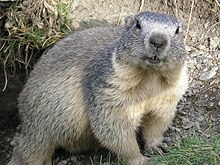Alpine marmot
| Alpine marmot | |
|---|---|
 |
|
| An alpine marmot in the regional park of the Queyras in France | |
| Scientific classification | |
| Kingdom: | Animalia |
| Phylum: | Chordata |
| Class: | Mammalia |
| Order: | Rodentia |
| Family: | Sciuridae |
| Genus: | Marmota |
| Species: | M. marmota |
| Binomial name | |
|
Marmota marmota (Linnaeus, 1758) |
|
The alpine marmot (Marmota marmota) is a species of marmot found in mountainous areas of central and southern Europe. Alpine marmots live at heights between 800 and 3,200 metres in the Alps, Carpathians, Tatras, the Pyrenees and Northern Apennines in Italy. They were reintroduced with success in the Pyrenees in 1948, where the alpine marmot had disappeared at end of the epoch. They are excellent diggers, able to penetrate soil that even a pickaxe would have difficulty with, and spend up to nine months per year in hibernation.
An adult alpine marmot may stand at 18 cm (7.1 in) at the shoulder. They reach between 42 and 54 cm (17 and 21 in) in length, not including the tail, which measures between 13 to 16 cm (5.1 to 6.3 in) on average. The body mass is significantly lighter in spring, when these animals weigh 2.8 to 3.3 kg (6.2 to 7.3 lb), than in fall, when they weigh 5.5 to 8 kg (12 to 18 lb). The alpine marmot is sometimes considered the largest squirrel species, although the closely related hoary marmot is sometimes heavier. Its coat is a mixture of blonde, reddish and dark gray fur. While most of the alpine marmot's fingers have claws, its thumbs have nails.
As its name suggests, the alpine marmot ranges throughout the European Alps, ranging through alpine areas of France, Italy, Switzerland, Germany, Slovenia and Austria. They have also been introduced elsewhere with sub-populations in the Pyrenees, France's Massif Central, Jura, Vosges, Black Forest, Apennine Mountains, High Tatras, and the Romanian Carpathians. Marmots are abundant in their core population; in the Romanian Carpathians, for example, the population is estimated at 1,500 individuals. Alpine marmots prefer alpine meadows and high-altitude pastures, where colonies live in deep burrow systems situated in alluvial soil or rocky areas.
...
Wikipedia

